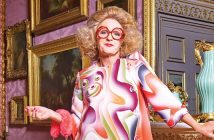Jean-David Malat has an unashamedly shrewd eye for the business of art, and the art of business. Director of the Opera Gallery in London, he has a knack of identifying new artists and divining what will sell. Hot on the heels of February’s record breaking modern and contemporary art sales at Sotheby’s and Christies, Jean-David has put together a show designed to question our very understanding of commerciality in art.
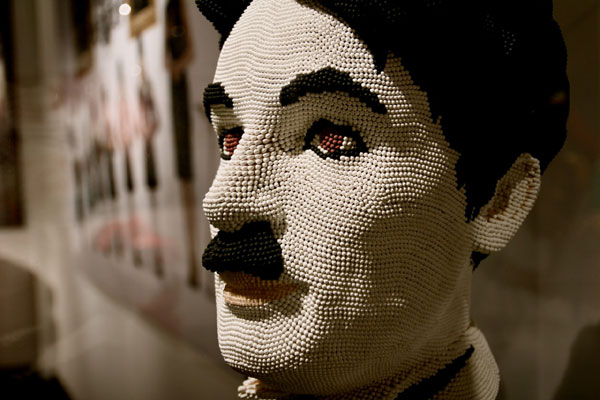
Charlie Chaplin by David Mach
Showing seminal works, such as Andy Warhol’s Guns and Chairman Mao, alongside developing and up-and-coming artists, Opera challenges what we know to be commercially valuable, and what we perceive might be valuable.
The show, entitled Contemporary Masters, spans several decades, and introduces us to a complete variety of textures and materials. From paint poured onto aluminium, to busts made from coat hangers, collages made up of tiny strips of photographs and portraits made of vinyl, our expectations are challenged. But there is humour in these works – they’re designed to titillate us as much as please any sense of aesthetics.
One example is a bust of Charlie Chaplin created by David Mach from matchsticks. Beautifully rendered in 3D, the colouration in the bust is achieved by selecting variously tinted matchsticks, and in some instances entirely reversing the matchstick to use the blunt square end. The result is an incredibly tactile piece, so much so that Charlie is encased in a glass box to stop people like me from running my hands through his apparently luscious curls.

Elly, gallery assistant 3 (2001) by Opie
Another example of the mundane made new is the paper sculpture of a Big Mac 2010 by Pavlos. Initially amused, I was drawn into the incredibly elaborate and detailed folds of paper – movement is created by interleaving different colours and patterns together until the burger comes into complete focus. I mentioned this piece to Jean-David, and he informed us that Pavlos is now nearly ninety and suffers from Parkinson’s disease – although does not suffer while he’s working. I can’t imagine how long it would take to conceive and make such a piece under those circumstances, but the effect is mesmerising.
There are also two Opie’s on display: In Elly, gallery assistant 3 (2001), you’re particularly drawn to the warmth of the material – these portraits are made from layered vinyl and are both textured and smooth, but have depth engendered by layering the vinyl to achieve minute highlights. Again, I’m tempted to sweep my hand across that silky surface. Julian is another artist who is working in many different arenas, from these portraits, to sculpture, to filmed compositions combining moving images and music, and animation. There is an increasing trend for contemporary artists, including Damien Hirst who is also represented in the show, to explore a range of avenues – not to eliminate them, but as a further expression of their artistic sensibilities.
By contrast to the smooth Opie, two busts made from coat hangers are spiky, almost defensive in their rejection of our touch, cool and prickly to the eye. Created again by David Mach, they are diminutive cousins of Silver Streak, the 10ft gorilla he displayed to such effect at last year’s Royal Academy Summer Exhibition. The Marilyn bust is immediately identifiable even from a distance, and at a distance seems set in soft focus, with her hooky nimbus.
Close by is another rendering of Marilyn – this time Mach has created her from hundreds of tiny cut strips of photographs. Part montage, part mosaic, Marilyn shimmers under our scrutiny and you have to step back to see her as a whole.
Another textural delight is Arman’s Starry Night (1995), discernibly a tribute to Van Gogh’s 1889 Starry Night, this version is stuccoed with used paintbrushes, bristling from the painting like a sea urchin. The brushes seemed so fresh that it made me want to snap one off and grab a tube of paint.
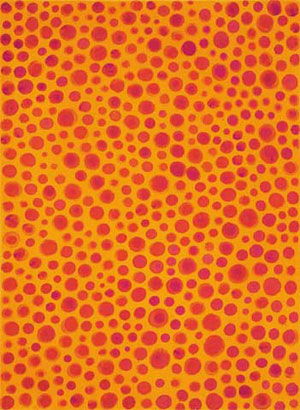
Dots (1999) by Yayoi Kusama
With the increasing globalisation of the art market, collectors are emerging from newly wealthy regions, interested in collecting both national and international art. In some instances the artists from these regions are drawn more to their external marker for political reasons. Opera has several examples of international artists, including Yayoi Kusama of Japan, and Yue Minjun of China. The latter’s works are immediately recognisable, with Yue’s multiplicity of self-portraits, caught in the moment of laughter. Sometimes the settings are completely incongruous, such as both the victim and perpetrator in a firing squad, and dressed as Marilyn. This month’s Harvard Business Review, which is all about the subject of happiness, features a number of Yue Minjun’s pieces, and discusses the benefits of laughing and happiness within our lives. At Opera you can see his Hero here (2004) work.
Also on show is an example of Jean-Michel Basquiat, whose Orange Sports Figure sold last week for £4.03m, well above its estimate of £3-4m, following the discovery that Basquiat had signed the painting with invisible ink. On display in the Opera Gallery is Basquiat’s Logo (1984), created two years later and equally powerful. Since his death in 1988, Basquiat continues to influence the market, with a new generation of artists inspired by his style.
This show sets out to question our relationship with the commerciality of art, and last week’s auction surpassed all expectations. At Christies, over £109m of sales were achieved, a record for London, and seventeen lots sold for over £1m. One portrait by Francis Bacon sold for £21.2m, the highest price for a contemporary artist at this sale since February 2008.
At Sotheby’s over £66m was achieved, with Gerhard Richter dominating their sales with six paintings reaching over £17.6 million. Richter also had four paintings in the ten most expensive sold over the two days and the increase in prices reflected the record amounts set for his work in November auctions in New York. Confirming his place as one of the most desirable artists, every available piece in the London auctions was sold as collectors sought to secure their own piece.
There is absolutely no doubt that the modern and contemporary markets are buzzing. For just a few days you can go to the Opera Gallery yourself and see what Jean-David thinks is interesting, challenging and up-and-coming. We may not be able to afford these prices, but we should all take the opportunity to see some of these pieces first-hand, before they disappear into the hands of the private collectors.
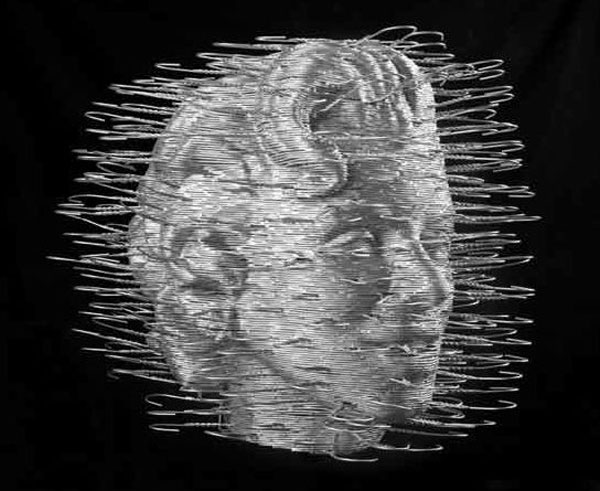
Marilyn Head in Coat Hangers by David Mach
I took the opportunity to ask Jean-David what we should be looking out for when purchasing contemporary art for ourselves:
What flash of recognition do you get when you identify a new artist, and how are you able to define so accurately what you think will sell?
“I am watching art and discovering new artists and new art all the time. What I like best is when an artist or his work really catches my attention, makes me physically stop to view it longer. I am always looking for something unique and different, and I am interested by artists who push the boundaries of physical possibilities and show how far we can go with the making of art. I am passionate about art and when you really believe in the artist you are selling, your clients and collectors will follow your passion and trust you.”
Is there a way for us to identify those trends for ourselves when looking to invest in new pieces?
“A good knowledge of art history and of the art market is the only way to identify these. But my first advice is always to buy pieces that you like. Whether they turn out to be a good investment or not, you get to enjoy them and that’s the most important thing about a piece of art! Other than that, if you yourself do not have the knowledge needed to invest wisely in the art market, seeking professional advice is the safest thing to do. As an art dealer, I have worked with people with bigger or smaller budgets but great passion and trust and I have helped them built strong and valuable art collections over the years.”
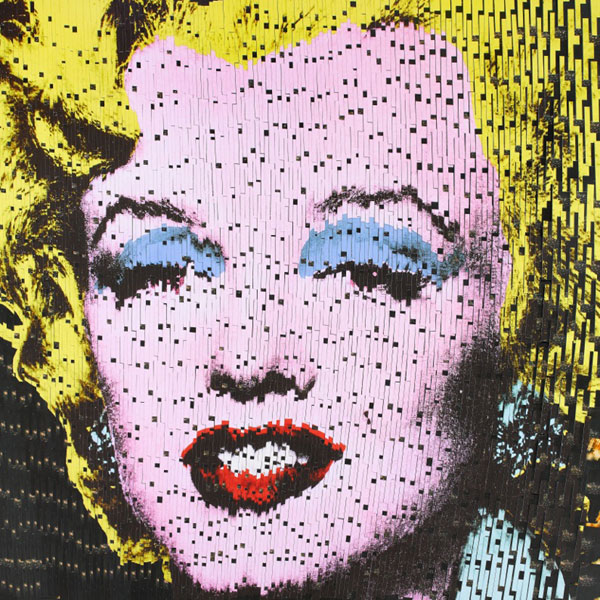
Marilyn - mixed media postcards on woodm - by David Mach
How can galleries do more to encourage the public to come in and view their pieces, without feeling that they are required to buy?
“Art exhibitions are the best way. Selling is necessary for a gallery to survive, but art exhibitions are the window of their activity. Not anyone can buy a piece of art, but everyone can enter an art gallery and get a glance at the art of the moment. Creating a fun and entertaining event and yet ensuring a display of good quality is the key for a gallery to gain visibility and raise its public image.”
With an increasingly multi-disciplined market, which new mediums do you think will become more readily available to new collectors?
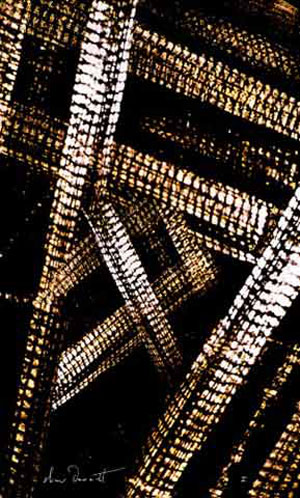
Résilles by Olivier Dassault
“I believe that photography is the genre of the century. In November 2011, the ever most expensive art photograph was auctioned in Christie’s in New York for 3.1 million Euros. It is a photo of a landscape by Andreas Gursky, and an amazing piece. At the occasion of the sale, Pierre Cornette de Saint Cyr said: ‘I am thrilled that one finally understands photography is a major art! 90% of graphic creations from the 19th and early 20th centuries have been disregarded! We used to think that a portrait by Nadar was not art! The renowned painter Ingres himself said in 1860, while “stealing” and hiding Nadar’s photographic plates: Photography is such a beautiful thing that they must not know about it!’
“Photography is indeed an amazing genre: it allows a great power of criticism of the society – like Gerard Rancinan does so well, who will be exhibited at this year’s Milan Triennale. It is a versatile genre as well, that can be either figurative as the art of the above-mentioned artists, but also abstract as is the avant-garde photography of Olivier Dassault.
“Apart from photography, I always find mixed media artworks and installations that use unexpected materials both very exciting and entertaining. I shall of course mention Royal Academician David Mach sculptures – they’re breathtaking!”
Contemporary Masters runs until Friday 2nd March at the Opera Gallery, New Bond Street, London W1S 2TF. For more information about Opera Gallery, visit the website.


